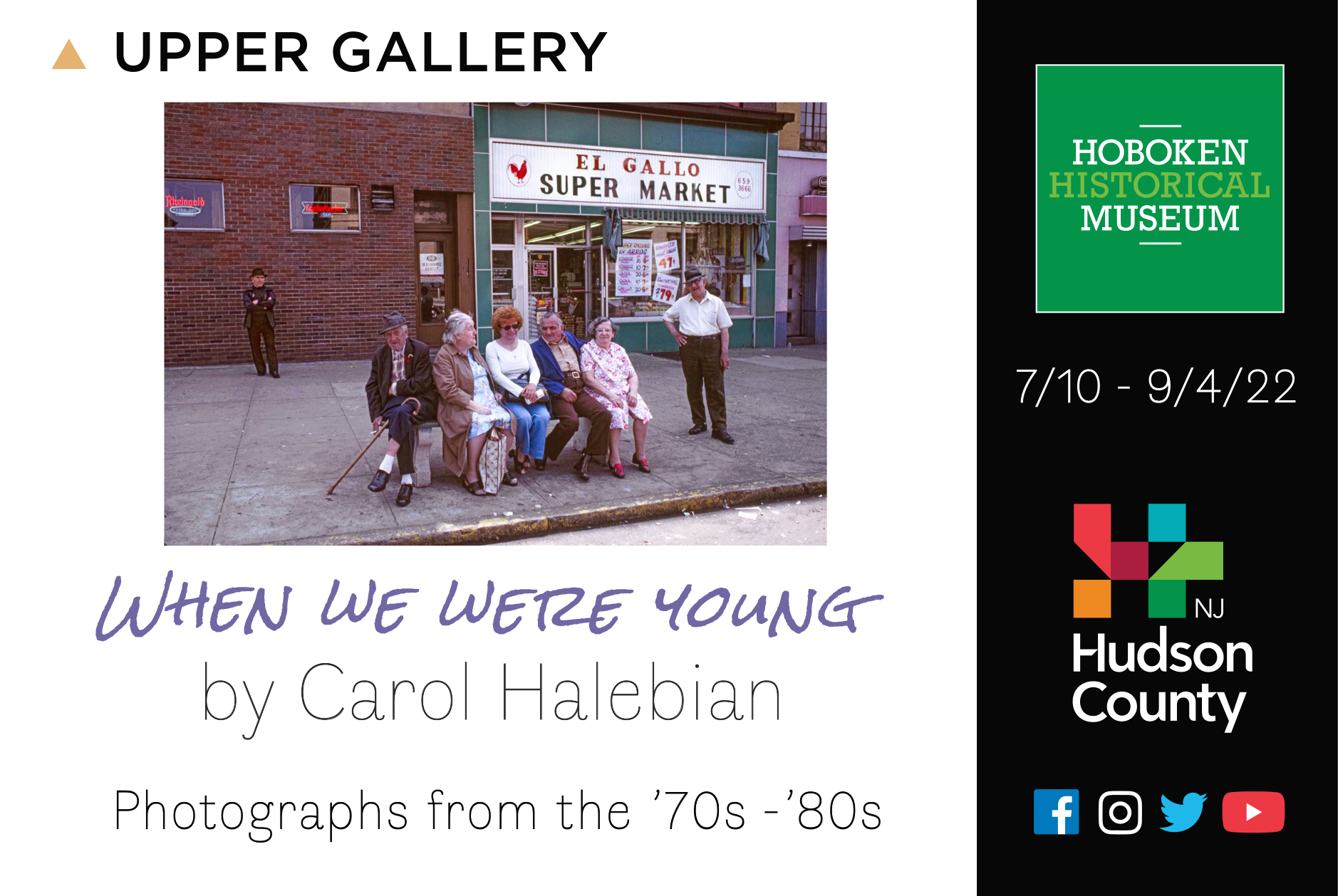Carol Halebian: When We Were Young
July 10 2022 – September 4, 2022

We are thrilled to present photography by Carol Halebian, in our new Upper Gallery exhibit, “When We Were Young.” We’re showing select images form the Kodachrome film she shot of Hoboken Street life between the late 70s and early 80s. The exhibit opens Sunday, July 10 with a reception at 2 pm and runs until Sunday, September 4. Before the opening, Carol will be interviewed by Museum Director and photographer Bob Foster in an online Artist Talk Friday, July 8 at 7pm, streamed out live on both YouTube and Facebook
Carol Halebian grew up in Bergen County. She attended Syracuse University and majored in Photojournalism. On a trip to Europe, she found herself marveling at the sights along with her with fellow photography students. A professor remarked, “Don’t overlook your own backyard!” Her initial awareness of Hoboken came from the signs she saw on the approach to the Lincoln Tunnel. She was intrigued, and made her first visit here on Election Day, 1976. Carol was fascinated at how “the sidewalks became like second living rooms,” hosting card games and all manner of get-togethers. She loved the low buildings and vibrant street culture. She also was seeing the urban landscape “change rapidly.” The words ‘gentrification’ and ‘yuppie’ were commonly used in the conversations naming these changes. Carol realized that the rapidly changing Hoboken was just the place – her “own backyard” – to focus her photographer’s eye. So she began chronicling the street life in Hoboken regularly and in earnest, with her beloved Kodachrome film. “When We Were Young” shows select images taken between the late 1970s and early 1980s.
Carol’s grandmother emigrated to the US in 1920 when she was 17 as a refugee from the Armenian Genocide. She came in on a ship that docked in Hoboken and was quickly taken home by a member of her extended family that was already here for a bath. Poor immigrants traveling over the Atlantic in ‘steerage’ were vulnerable to lice, among other medical issues, and the fortunate ones had family or friends ready to administer the serious baths needed to minimize and address infestations.
As she prepared for this exhibit, Carol found herself reflecting. She was moved to describe her impressions of Hoboken, and the circumstances that led her to photograph in Hoboken forty years ago. These are her reflections:
“The first time I saw Hoboken, I thought it was a period piece in slow progress. It was a presidential election day, 1976, Ford vs. Carter and my first day off from work. I had recently graduated from the Newhouse School at Syracuse University with a photojournalism major and a sociology minor. Employed at a photography magazine, my plan was to photograph, maybe even start a long-term project. Until that day, Hoboken was a word on a traffic sign, the place a motorist would avoid by turning in the direction of the Lincoln Tunnel for Manhattan.
Hoboken was literally “the road not taken.” It was also the butt of endless jokes, an underdog. My cousin Barbara and I, both having grown up in Bergen County, decided to explore. We parked and wandered around, smelling coffee in the air for blocks from Maxwell house, the world’s largest coffee plant. I shot one roll of my favorite film, Kodachrome. Not only the subject of a hit Paul Simon song, Kodachrome was considered to be the most stable of the slide films. Black and white could last forever, but color could fade.
It was a brief, but memorable visit. I had stumbled upon a photographic gem, a place where people are open, the quality of light is warm, bright, and beautiful. The predominant color matched my favored film’s distinctive red. In this mile square city, the street was a second living room, a meeting ground, and a melting pot. It was not unusual to see three generations enjoying an afternoon on a stoop. My first impression was that the clock had stopped about forty years ago.
My photographic approach was direct. In most situations, I walked up to people because I was attracted to an expression, a gesture, stance, attitude, or activity. Each encounter became a mini collaboration. There were so many kinds of people of different ages, classes, and cultures living side by side. The mix was changing because Hoboken was in the process of being “discovered” by people priced out of Manhattan who appreciated the proximity to New York and the charm of a unique city with a rich history. While some people may laugh at the very sound of “HoBoKen,” its inhabitants are house and city proud.
I spent many days slowing scouting about, familiarizing myself with the grid of short blocks and long streets. There were no concrete canyons to block the sun, only an unending tangle of telephone wires. Few buildings were more than four or five stories high. A curious situation was obvious, in several places row houses were crumbing, while in other areas they were being painstakingly renovated. It was the beginning of gentrification. Selected to be part of the federally funded “Model Cities” plan, the availability of low interest loans resulted in an influx of families seeking bargain brownstones along with speculators and investors. There were fires, some most likely arson, lots of “For Sale” signs and telltale scaffolding. There was development, re-development, and restoration. Hoboken entered a new stage of life, no longer the butt of jokes, and still a rich and vibrant community.
I continued to photograph in Hoboken until about 1984 when President Reagan passed through during his re-election campaign. While there have been many changes, Hoboken remains a unique city with a rich past and a promising future.”
The exhibit is supported by a block grant from the State/County Partnership program for the Arts, administered by the Hudson County Division of Cultural and Heritage Affairs.
